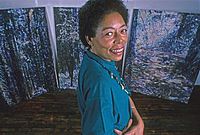Vivian E. Browne facts for kids
Quick facts for kids
Vivian E. Browne
|
|
|---|---|
 |
|
| Born | April 26, 1929 |
| Died | July 23, 1993 (aged 64) |
| Nationality | American |
| Education | Hunter College |
| Known for | Painting |
Vivian E. Browne (born April 26, 1929 – died July 23, 1993) was an American artist. She was born in Laurel, Florida. Vivian Browne was famous for her paintings that protested unfair treatment of African Americans. She also connected abstract art to nature. She won many awards for her art. She was also an activist, a professor, and helped start many art galleries. Vivian Browne passed away at 64 years old.
Contents
About Vivian Browne
Vivian Browne was born in Laurel, Florida, on April 26, 1929. She lived most of her life in New York City and Kern County, California. She studied at Hunter College in New York. She earned her first degree in 1950 and a higher degree in fine arts in 1959.
Vivian Browne received scholarships early in her painting career. These included help from the New School for Social Research. She also got fellowships from the Huntington Hartford Foundation in 1964 and the MacDowell Colony.
She loved to travel, especially in Europe and Africa. In 1972, she studied at the University of Ibadan in Nigeria. From 1971 to 1992, Browne taught at Rutgers University in Newark. She also continued to create her own art and had shows across the country.
Art Exhibitions
Vivian Browne had many solo art shows. These took place at the SoHo 20 Gallery. She also showed her art at the Bronx Museum. Other places included the University of California, Santa Cruz and Western Michigan University. In 1986, her work was shown at MoMA PS1's Clocktower Gallery.
After she passed away, her art continued to be shown. In 2017, her work was part of an exhibit called We Wanted a Revolution: Black Radical Women, 1965–85. This show was put together by the Brooklyn Museum.
In 2018, her art was in another exhibition. It was called Acts of Art and Rebuttal in 1971. This show at Hunter College looked back at a 1971 exhibition. That earlier show, Rebuttal to the Whitney Museum Exhibition: Black Artists in Rebuttal, protested the Whitney Museum. The Whitney Museum had refused to hire a Black curator for their art survey. Vivian Browne had been considered for the Whitney's exhibition but was not included.
Art Collections
Vivian Browne's art is held in many public and private collections. These are found all over the United States. Most of her work is in New York and California.
Some important places that have her art include the Smithsonian. Her work is also at the MOMA. The Schomburg Center in New York City also has her pieces. Other collections include Chase Manhattan Bank and the John Cotton Dana Library. Her art is also part of the Hatch-Billops Collection and the Wadsworth Atheneum Museum. The New York Public Library and the private collections of Harry Belafonte and Rosa Parks also hold her work.
Vivian Browne is featured in a special online exhibit. It is at the Center for the Women in the Arts and Humanities. This center is located at Rutgers University.
Activism Through Art
Many of Vivian Browne's artworks show her feelings about growing up. She felt that Black women faced many struggles and were often treated unfairly. She once said, "Black art is political. If it's not political, it's not black art." This means she believed art by Black artists often carries a message about their experiences.
She fought for equality for all people. However, she was not always hopeful that attitudes would change quickly. She saw her art in two ways. She said, "When I am political, I am painting as a black or as a woman or both. Otherwise, I am just a member of the human race." This shows her art could be about her identity or about general human experiences.
Vivian Browne taught the History of Black Art at Rutgers University. She was also the chair of that department from 1975 to 1978. She helped and advised a feminist art publication called HERESIES: A Feminist Publication on Art and Politics. She even helped edit an issue focused on racism.
Key Achievements
Vivian Browne was a professor and department chair at Rutgers University. She was especially recognized for her political artworks. These paintings showed her life as a Black woman.
In 1990, she served as a panelist for the Fulbright program. During the 1970s and 1980s, she spent a lot of time curating art shows. She also participated in many art discussions. Some of these included the 1971 Art Student's League's Symposium on Afro-American Art. She also took part in the National Conference of Artists in 1973, 1974, and 1976.
She was also part of the Soho20 Chelsea, an art gallery on Broome Street. Vivian Browne was featured in over 80 group and solo exhibitions. These included shows at the Museum of Modern Art (MoMA). Her art was also shown at the Orlando Gallery and the Black Art Festival in Atlanta, Georgia.
Awards and Honors
Vivian Browne received many awards during her life.
- Huntington Hartford Painting Fellowship, Pacific Palisades, CA, 1963
- Achievement Award, National Association of Business and Professional Women
- Research Council Grants, Rutgers University, NJ
- MacDowell Colony Fellowship, Peterborough, NH
- Visiting Artist, University of California at Santa Cruz, Santa Cruz, CA
- Artists and Influence, Hatch-Billops Collection, New York, NY
- Guest of Honor, New York Feminist Art Institute, Women's Center for Learning, New York, NY
- Distinguished Teacher of Art, College Art Association, New York, NY
- "Mayor Koch Honors Six Black Artists," City Hall, New York, NY, 1986

